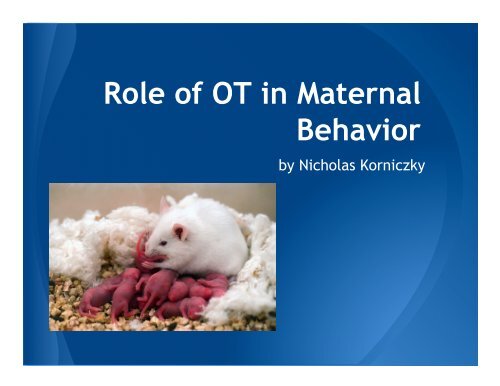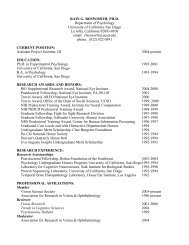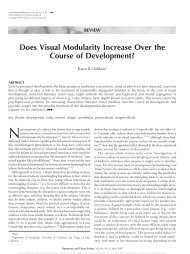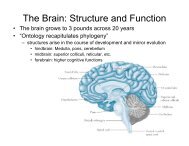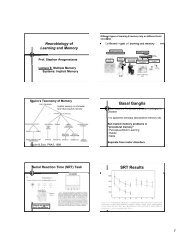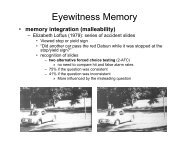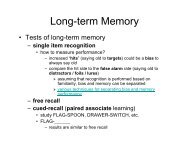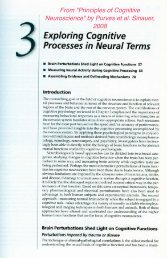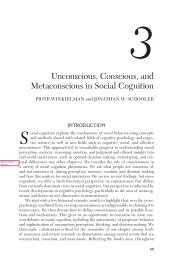Role of OT in Maternal Behavior
Role of OT in Maternal Behavior
Role of OT in Maternal Behavior
Create successful ePaper yourself
Turn your PDF publications into a flip-book with our unique Google optimized e-Paper software.
<strong>Role</strong> <strong>of</strong> <strong>OT</strong> <strong>in</strong> <strong>Maternal</strong><br />
<strong>Behavior</strong><br />
by Nicholas Korniczky
Young et al. Claim<br />
"<strong>OT</strong>, both <strong>in</strong> the periphery and bra<strong>in</strong>, also<br />
plays an important role <strong>in</strong> behaviors<br />
associated with maternal care, <strong>in</strong>clud<strong>in</strong>g<br />
uter<strong>in</strong>e contraction at parturition, milk<br />
ejection dur<strong>in</strong>g lactation and the regulation<br />
<strong>of</strong> maternal behavior <strong>in</strong> females."
Terms:<br />
parturition: childbirth<br />
anxiolytic: related to feel<strong>in</strong>gs <strong>of</strong> anxiety<br />
peripartum period: occurr<strong>in</strong>g dur<strong>in</strong>g the last month <strong>of</strong><br />
gestation or the first few months after delivery, with<br />
reference to the mother<br />
dams: the female parent <strong>of</strong> an animal
Oxytoc<strong>in</strong><br />
Oxytoc<strong>in</strong> that is secreted <strong>in</strong>to the systemic circulation is<br />
produced by about 9000 magnocellular neurons, many <strong>of</strong><br />
which are aggregated <strong>in</strong> two hypothalamic nuclei:<br />
• supraoptic nucleus (SON)<br />
• paraventricular nucleus (PVN)<br />
Effects:<br />
• suppress appetite<br />
• stimulates male sexual arousal, female sexual receptivity<br />
• groom<strong>in</strong>g behavior<br />
• is antianxiolytic (<strong>in</strong>creases anxiety)
<strong>OT</strong>/AVP released <strong>in</strong>dependently<br />
dur<strong>in</strong>g parturition<br />
• Once thought that they were both released<br />
together<br />
• However, evidence shows that they are released<br />
<strong>in</strong>depently because their rates <strong>of</strong> release are<br />
different and <strong>in</strong>dependant
<strong>OT</strong>/AVP<br />
Experiment<br />
Note: Lower bar represents <strong>OT</strong>/<br />
VP be<strong>in</strong>g depleted.<br />
Taken from:<br />
Pituitary oxytoc<strong>in</strong> and vasopress<strong>in</strong> content <strong>of</strong> pregnant rats<br />
before, dur<strong>in</strong>g and after parturition. [Endocr<strong>in</strong>ology. 1971]
Milk Ejection Reflex<br />
• When a lactat<strong>in</strong>g mammal is suckled by its<br />
young, the magnocellular neurons fire<br />
<strong>in</strong>termittently <strong>in</strong> brief, <strong>in</strong>tense bursts <strong>of</strong> action<br />
potentials, each <strong>of</strong> which triggers oxytoc<strong>in</strong><br />
release<br />
• Why Oxytoc<strong>in</strong> <strong>in</strong> IMPORTANT: lactation can be<br />
blocked by small amounts <strong>of</strong> oxytoc<strong>in</strong> antagonist<br />
<strong>in</strong>jected <strong>in</strong>to the SON (supraoptic nucleus)<br />
o large amount <strong>of</strong> <strong>OT</strong> release will counteract<br />
this
<strong>OT</strong> Animal Variations: Sheep vs.<br />
Rats<br />
• An ewe is able to recognize her own lamb from the<br />
moment it is born, and she feeds it alone.<br />
• This <strong>in</strong>volves an ‘olfactory memory’ <strong>of</strong> the lamb that is<br />
fixed by neural pathways activated at parturition by<br />
centrally released oxytoc<strong>in</strong><br />
• Virg<strong>in</strong> and early pregnant rats typically avoid contact<br />
with newborn pups, but at the end <strong>of</strong> pregnancy, when<br />
the neural circuits regulat<strong>in</strong>g maternal behavior are<br />
established, rats lose this apprehension.
Sheep vs. Rats (cont.)<br />
• 'Motherhood' changes the<br />
neuroendocr<strong>in</strong>e response<br />
o Now oxytoc<strong>in</strong> will release <strong>in</strong>to the blood and<br />
hypothalamus follow<strong>in</strong>g emotional, physical,<br />
or pharmacological stressors that are<br />
attenuated <strong>in</strong> the peripartum period
<strong>Maternal</strong> Aggression<br />
• Levels <strong>of</strong> aggression are l<strong>in</strong>ked to anxiety<br />
o rats selectively bred for high anxiety-related<br />
behavior (HAB) are more aggressive than rats bred<br />
•<br />
for low anxiety-related behavior (LAB).<br />
Oxytoc<strong>in</strong> release with<strong>in</strong> the PVN and central nucleus <strong>of</strong><br />
the amygdala (CeA) is higher <strong>in</strong> HAB than <strong>in</strong> LAB dams,<br />
and blockade <strong>of</strong> <strong>OT</strong>R by bilateral <strong>in</strong>fusion <strong>of</strong> an <strong>OT</strong>R<br />
antagonist directly <strong>in</strong>to the PVN or CeA reduced<br />
aggression <strong>in</strong> HAB dams, whereas <strong>in</strong>fusion <strong>of</strong> synthetic<br />
oxytoc<strong>in</strong> <strong>in</strong>to the PVN <strong>in</strong> LAB dams tended to <strong>in</strong>crease<br />
maternal aggression
Possible Adaptations<br />
• Possibly <strong>in</strong> anticipation <strong>of</strong> parturition <strong>in</strong> late<br />
pregnancy, oxytoc<strong>in</strong> neurons become less sensitive<br />
to stressful stimuli and to hyperosmotic stimuli.<br />
• This hyporesponsiveness may be important to<br />
allow pituitary stores <strong>of</strong> oxytoc<strong>in</strong> to accumulate <strong>in</strong><br />
expectation <strong>of</strong> the large demand for oxytoc<strong>in</strong><br />
dur<strong>in</strong>g parturition and lactation, and to reduce the<br />
risk <strong>of</strong> premature delivery.
Other thoughts/Possible<br />
Implications<br />
• The extent to which changes are adaptations to<br />
facilitate the <strong>in</strong>fluence <strong>of</strong> oxytoc<strong>in</strong> or which are<br />
consequences <strong>of</strong> <strong>in</strong>creased activity <strong>in</strong> the systems.<br />
• However, the potential ability <strong>of</strong> oxytoc<strong>in</strong> to ‘reprogramme’<br />
its neural targets by alter<strong>in</strong>g functional<br />
connectivity is an attractive concept for understand<strong>in</strong>g<br />
maternal behavior, but this rema<strong>in</strong>s to be tested.
References<br />
87. Fuchs A-R, Saito S. Pituitary oxytoc<strong>in</strong> and vasopress<strong>in</strong> content <strong>of</strong> pregnant<br />
rats before, dur<strong>in</strong>g, and after parturition. Endocr<strong>in</strong>ology. 1971;88:574–578.<br />
[PubMed]<br />
142. Leng G, Meddle SL, Douglas AJ. Oxytoc<strong>in</strong> and the maternal bra<strong>in</strong>. Curr<br />
Op<strong>in</strong> Pharmacol. 2008;8:731–734. [PubMed]


